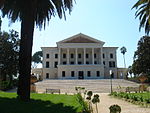Congregation of the Blessed Sacrament
1856 establishments in FranceCatholic missionary ordersCatholic orders and societiesCatholic religious orders established in the 19th centuryInstitutes of consecrated life ... and 2 more
Religious organisations based in ItalyReligious organizations established in 1856

The Congregation of the Blessed Sacrament (Latin: Congregatio Sanctissimi Sacramenti), commonly known as the Sacramentinos is a Catholic Clerical Religious Congregation of Pontifical Right for men (priests, deacons, and brothers) founded by St. Pierre-Julien Eymard. Its members use the nominal letters S.S.S. which is the acronym of its official name in Latin, after their names. By their life and activities, they assist the Church in her efforts to form Christian communities whose center of life is the Eucharist. They commit themselves to the implementation of this ideal in collaboration with lay men and women engaged in various ministries.
Excerpt from the Wikipedia article Congregation of the Blessed Sacrament (License: CC BY-SA 3.0, Authors, Images).Congregation of the Blessed Sacrament
Via Giovanni Battista De Rossi, Rome Nomentano
Geographical coordinates (GPS) Address Nearby Places Show on map
Geographical coordinates (GPS)
| Latitude | Longitude |
|---|---|
| N 41.917166666667 ° | E 12.517916666667 ° |
Address
Via Giovanni Battista De Rossi
Via Giovanni Battista De Rossi
00162 Rome, Nomentano
Lazio, Italy
Open on Google Maps









